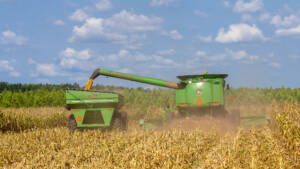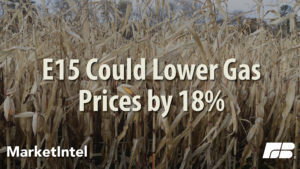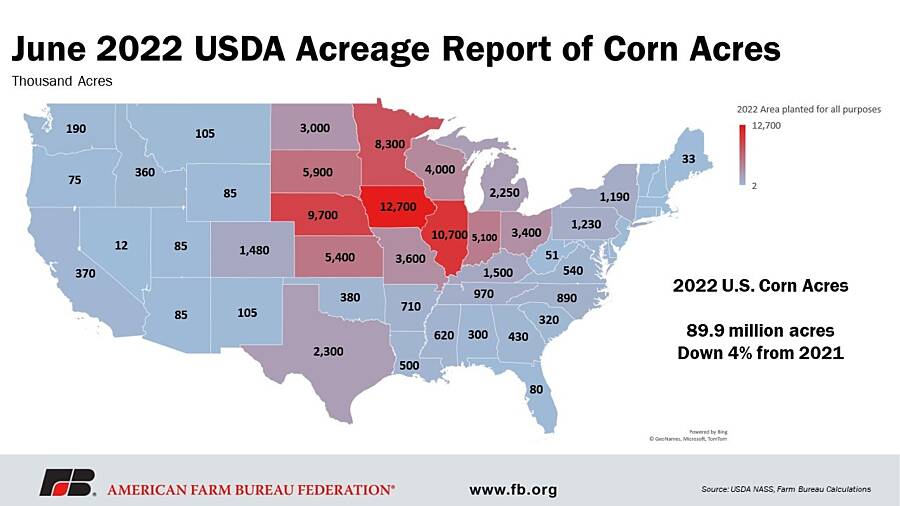June Acreage Report Puts Corn Back on Top

Shelby Myers
Former AFBF Economist
USDA’s June 30 Acreage report, which is a survey-based update of planted acres for the current crop year, indicates that for the 2022/23 crop year, farmers planted 88.3 million acres of soybeans, up 1% or 1.13 million acres, compared to 2021. This is, however, a significant decrease (2.6 million fewer planted acres) from the survey-based projections of the March Prospective Plantings Report. Corn planted acres are reported to be 89.9 million acres, down 4% or 3.4 million acres from 2021, and an increase of about 431,000 acres from what was reported in March intended acres. Cotton acres are reported at 12.5 million acres, an increase of over 1.2 million acres or 11% from 2021 but an increase of about 244,000 acres compared to intentions declared earlier this year. Wheat planted acres are reported at 47.1 million, up 1% from 2021 and a decrease of nearly 260,000 acres compared to the March Prospective Plantings report. The acreage report for all four commodities indicates farmers planted about 2.3 million acres less than what was indicated in the March report. However, USDA has indicated that a special follow-up survey will be carried out due to the significant number of acres, 4 million in corn and 15.8 million in soybeans, left to be planted, per farmers’ stated intentions.
Ahead of the report’s release, market analysts did not expect major changes to corn and soybean planted acres, despite the corn price remaining elevated through the spring. Much of the conversation focused on whether farmers would switch to corn, despite the higher planting costs, in hopes that the revenue received in the fall would be higher than soybean returns. Today’s report indicates that farmers made small shifts to plant a few more acres of corn and cotton and pulled acres from soybeans and wheat, likely due to weather-related delays. The combined acreage total for corn and soybeans in 2022 is 178.2 million acres, which is lower than 2021’s 180.6-million-acre record, and lower than the 180.5 million acre-combined estimate first presented at the February Agriculture Outlook Forum, which presented estimates for U.S. and global production before Russia invaded Ukraine and global market volatility ensued.
2022 Soybean Planted Acres
Market analysts only expected a slight decrease in soybean planted acres – 509,000 acres – from farmers’ intentions in March. In the USDA June 30 Acreage report, farmers say they planted 88.3 million acres of soybeans, a decrease of about 2.6 million acres compared to March expectations of a record 91 million acres. USDA estimates 15.8 million acres of soybeans are still left to be planted in 2022, up nearly 61% compared to this time in 2021 when 9.8 million acres of soybeans were still left to be planted. Illinois is expected to lead the country in planted soybean acres with 11.2 million acres, an increase of 6% compared to 2021 when 10.6 million acres were planted. Iowa follows with 10.3 million acres of soybeans planted, up 2% from 2021 when 10.1 million acres were planted. Minnesota has an estimated 7.5 million acres of soybeans planted, down 2% from 2021 when 7.65 million acres were planted. Tennessee reported the largest increase in soybean acres planted, increasing by 16% from 2021 when 155,000 acres were planted to 180,000 acres in 2022. Virginia has the second-largest increase, 13%, going from 600,000 acres of soybeans planted in 2021 to 680,000 acres in 2022. The third-largest increase, also a 13% percent jump, is expected in Alabama, where farmers are going from 310,000 acres in 2021 to 350,000 acres in 2022.
Maps below highlight USDA’s 2022 soybean acres planted and the year-over-year change from 2021.
2022 Corn Planted Acres
Pre-report estimates had analysts expecting farmers to only increase corn planted acres by 371,000 acres compared to farmers’ intentions in March. In the USDA June 30 Acreage report, farmers say they planted 89.9 million acres of corn, an increase of 431,000 acres compared to the March report, which indicated farmers intended to plant 89.5 million acres. USDA estimates just over 4 million acres of corn are still left to be planted in 2022, up 85% compared to acres left to be planted this time last year when 2.1 million acres of corn were still left to be planted. Iowa leads the way in corn acres planted with 12.7 million acres, a decrease of 2% compared to 2021 when 12.9 million acres of corn were planted. Illinois follows with 10.7 million acres of corn planted, down 3% from 2021 when 11 million acres were planted. And Nebraska has planted 9.7 million acres, down 2% from 2020 when 9.9 million acres of corn were planted. Utah is expected to have the largest percentage increase of corn planted acres, 21%, planting 85,000 acres in 2022 compared to 70,000 acres in 2021. Washington has the second-largest increase of corn planted acres, increasing 15% from planting 165,000 acres of corn in 2021 to planting 190,000 acres of corn in 2022. New York has the third-largest increase, 13%, rising from 1.05 million acres in 2021 to 1.19 million acres in 2022.
Maps below highlight USDA’s 2022 corn acres planted and the year-over-year change from 2021.
2022 Cotton Planted Acres
For cotton acres, market analysts anticipated farmers would report 12.194 million acres of cotton planted for the 2022 year, 40,000 acres fewer than what was stated in the March report. The June 30 Acreage report indicates farmers planted 12.5 million acres of cotton, up 244,000 acres compared to March expectations of 12.234 million acres. Texas is leading the way, reporting the largest number of all-cotton acres with 7.1 million acres of cotton planted, up 12% from 2021 when 6.3 million acres were planted. Behind Texas is Georgia, planting 1.2 million acres in 2022, up 3% from 2021 when 1.17 million acres were planted. Oklahoma has the third-largest all-cotton planted – 550,000 – up 11% compared to 2021 when 495,000 acres were planted. The largest percentage change in acres occurs in New Mexico where farmers are planting 63% more cotton acres in 2022 than in 2021, moving from 48,500 acres to 79,000 acres. Louisiana is the second-largest increase in cotton planted acres, increasing 55% in 2022 with 170,000 acres compared to 110,000 cotton acres planted in 2021. South Carolina is increasing cotton acres by the third-largest percentage, increasing 24% to 260,000 acres in 2022 compared to 210,000 acres in 2021.
Maps below highlight USDA’s 2022 cotton acres planted and the year-over-year change from 2021.
2022 Wheat Planted Acres
Pre-report, market analysts expected farmers would plant 47.017 million acres of wheat, just 334,000 acres less than intended acres reported in March. The June 30 Acreage report indicates farmers planted 47.1 million acres of wheat, down 259,000 acres compared to reported expectations in March. Kansas has the most all-wheat planted acres at 7.4 million acres, up 1% from 2021 when farmers in the state planted 7.3 million acres. Behind Kansas, North Dakota farmers have planted 6.5 million acres, up 1% from 2021 when 6.4 million acres were planted. Montana farmers planted the third-largest wheat area, nearly 5.6 million acres, up 1% from 2021 when 5.5 million acres of wheat were planted. Arizona has the largest increase in wheat plantings from 2021 to 2022, increasing 70% from 53,000 acres in 2021 to 90,000 acres. Delaware is increasing wheat planted acres by 33%, going from 60,000 acres planted in 2021 to 80,000 acres in 2022. Missouri increased wheat planted acres by 25%, the third-largest increase, going from 640,000 acres in 2021 to 800,000 acres in 2022.
Maps below highlight USDA’s 2022 wheat acres planted and the year-over-year change from 2021.
Summary
USDA’s June 30 Acreage report indicates farmers planted 88.3 million acres of soybeans, 89.9 million acres of corn, 12.5 million acres of cotton and 47.1 million acres of wheat for the 2022/23 crop year. Despite the slow start to plant this year because of heavy rains and cold soil temperatures across the country, farmers have indicated they were able to get most of their intended acreage planted. This is good news considering the growing demand for global grain and oilseed supplies resulting from the Russian invasion of Ukraine. This report also indicates that U.S. farmers made adjustments to planting intentions, shifting to a few more acres of corn and cotton and away from soybeans and wheat. Something to keep an eye on is the White House announcement to incentivize double-cropping on soybean acres and whether or not producers plant additional wheat acres after harvesting soybeans this fall.
Elevated commodity prices are another incentive to plant most commodities this year. However, weather challenges continue to plague the U.S., prompting USDA’s National Agricultural Statistics Service to resurvey for updated 2022 planted acres on barley, canola, corn, dry edible beans, oats, sorghum, soybeans, sunflowers, and durum and other spring wheat in Minnesota, North Dakota and South Dakota.
Now, as attention shifts to the growing season, key rains will be helpful to ensure the U.S. meets global production demands. Demand expectations will not be updated until the July 12 World Agricultural Supply and Demand Estimates, but early projections estimate that the numbers in the June Acreage report may still be low considering how many acres are left to be planted. It also underscores that despite global market uncertainty that continues to drive price volatility, farmers and ranchers have persevered.
What We're Saying

AFBF Advocates for Further Trade Discussions with China
Dec 4, 2025
READ MORE

Increased Biofuel Production, Year-Round Ethanol Could Bolster Farm Economy
Nov 13, 2025
READ MORE

E15: Boosting Corn Demand and Lowering Gas Prices
Nov 12, 2025
READ MORE

Farmers Encouraged by China Trade Agreement
Oct 30, 2025
READ MORE
Top Issues
VIEW ALL








